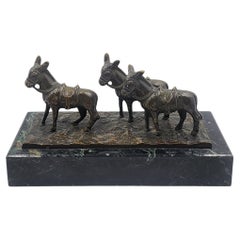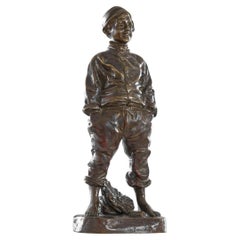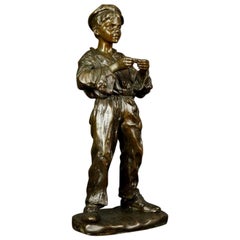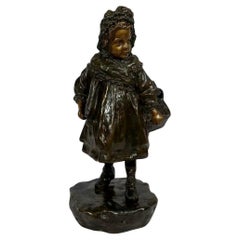Jose Cardona
Jose Cardona Ferro Bronze Sculpture
Located in San Francisco, CA
Jose Cardona Ferro: 1878-1923. Well listed Spanish artist also known as just Jose Cardona. He has
Category
Early 1900s Figurative Sculptures
Materials
Bronze
Bronze figure "Donkey Walk" by Jose Cardona signed
By José Cardona
Located in Autonomous City Buenos Aires, CABA
Bronze figure "Donkey Walk" by Jose Cardona, signed
Bronze sculpture titled "Donkey Walk" by the
Category
Antique 19th Century Spanish Art Nouveau Figurative Sculptures
Materials
Bronze
Josép Cardona i Furró Bronze Sculpture of a Boy
By José Cardona
Located in Tilburg, NL
Josép Cardona i Furró bronze sculpture of a boy. Spain, late 19th Century / early 20th century
Category
Early 20th Century Spanish Arts and Crafts Figurative Sculptures
Materials
Bronze
Paris modernist scene mixed media drawimg
Located in Sitges, Barcelona
was registered with the name of Juan Bautista José Pedro. His parents Josep Cardona i Farré (Sant
Category
1890s Modern Figurative Drawings and Watercolors
Materials
Mixed Media
$5,889 Sale Price
51% Off
H 15.75 in W 11.42 in
Recent Sales
Bronze Figurine of Young Boy Rolling a Cigarette Jose Cardona 20th Century
By José Cardona
Located in Liverpool, GB
.
Spain, early 20th century
Jose Cardona Furro (1878-1923) - Spanish sculptor, born in Barcelona. In 1906
Category
Early 20th Century Spanish Figurative Sculptures
Materials
Bronze
H 12.6 in W 5.91 in D 3.75 in
Bronze sculpture “The Schoolgirl”, by J. Cardona, after Pascau – 20th
By José Cardona
Located in HÉRIC, FR
Bronze print with multicolored patina (medal, brown, and green) signed José Cardona (1878-1922), a
Category
Early 20th Century French Figurative Sculptures
Materials
Bronze
French Bronze of a Seated Boy w/ Lit Lantern, Signed J. Cardona '1878-1923'
By José Cardona
Located in Petaluma, CA
lantern was cast in France by the listed artist Jose Cardona, who worked mainly just after the turn of the
Category
Vintage 1910s French Belle Époque Figurative Sculptures
Materials
Marble, Bronze
Antique and Signed Gilt Bronze Boy with Newspaper by the Fire Table or Desk Lamp
By Ferdinand Levillain, José Cardona
Located in Lisse, NL
Rare José Cardona (1878-1923) and Ferdinand Levillain (1837-1905) sculptural table lamp.
This
Category
Early 20th Century French Table Lamps
Materials
Alabaster, Bronze
H 12.6 in W 7.3 in D 4.5 in
People Also Browsed
Antique European Carved Gilt And Polychrome Coat Of Arms Wall Plaque
Located in Nuernberg, DE
We are delighted to offer for sale this highly collectable hand carved coat of arms featuring a knightly crest.
This is an exceptionally well made and decorative piece. It is a very...
Category
Early 20th Century Spanish Folk Art Arms, Armor and Weapons
Materials
Wood
$890
H 21.38 in W 17.75 in D 1.38 in
Art Deco Lamp
By Sofar
Located in Rebais, FR
Art Deco lamp with led in the foot.
Category
21st Century and Contemporary French Art Deco Table Lamps
Materials
Brass
Italian Bronze Garden Statue or Fountain of Pan Playing Flute, Early 20th C
Located in St. Louis, MO
Antique Italian bronze & copper garden statue or sculpture of pan playing flute while standing on a conch shell on an oval plinth. From an estate with a world class garden, in the gr...
Category
Vintage 1930s Italian Neoclassical Statues
Materials
Bronze, Copper
$12,500
H 54 in W 23.75 in D 18 in
Grand Scale Mahogany Custom Bookcase with Leaded Glass Sliding Doors
Located in Milford, NH
A fine large two-door bookcase with sliding leaded glass doors and adjustable shelves, originally a built-in floor to ceiling piece, with a cut-in on the left side, built around heat...
Category
Antique Late 19th Century American Bookcases
Materials
Glass, Mahogany
Art Deco Dressing Table and Mirror
By Sofar
Located in Rebais, FR
Art Deco dressing table with mirror and sconces.
Category
21st Century and Contemporary French Art Deco Wall Lights and Sconces
Materials
Brass
Attributed to Istvan Szonyi
By Istvan Szonyi
Located in Houston, TX
Hungarian Artist (1894-1960)
"Reclining Nude", circa 1920s
Measures: 19.5" H x 23.5" W, overall size is 28" x 32.5"
Oil on canvas, inscribed lower right "Somody baratomnak szere...
Category
Vintage 1920s Hungarian Other Paintings
Materials
Canvas
Pair of Jean Perzel Attributed 1940s Gilt Iron Wall Sconces
By Atelier Jean Perzel
Located in Sharon, CT
A pair of very large (27.5 inches high-exclusive of globes) Gilded Cast Iron (21 lbs. each) Wall Sconces. Not signed or otherwise marked.
Category
Vintage 1940s French Art Deco Wall Lights and Sconces
Materials
Iron
One-Off Winsor & Newton Queen Elizabeth Jubilee Sterling Silver 1977 Artist Box
By Windsor & Newton
Located in West Sussex, Pulborough
We are delighted to offer for sale this lovely one of a kind Winsor & Newton 1977 Queen Elizabeth Jubilee presentation with sterling silver plaques and boxes Calamander wood Artist b...
Category
20th Century English Early Victorian Sterling Silver
Materials
Crystal, Sterling Silver
$61,965
H 7.09 in W 20.48 in D 13.39 in
Italian Glazed Terracotta Figural Bust of Diana, Goddess of the Moon, Circa 1850
Located in Charleston, SC
Italian glazed and hand-painted terracotta figural bust of Diana raised on a two tiered circular faux painted plinth. Goddess of the moon, Mid-19th Century.
Category
Antique 1850s Italian Neoclassical Figurative Sculptures
Materials
Terracotta, Paint
$8,500
H 36.5 in W 26 in D 13 in
English Adam Gilt Marble Console Table
Located in Queens, NY
English Adam (circa 1780) gilt wood console with a carved frieze over rams head topped fluted legs with a stretcher & alabaster veneered marble top with a verde edge.
Category
Antique 18th Century English Neoclassical Console Tables
Materials
Alabaster, Marble, Gold Leaf
Oval Art Deco Chandelier
By Sofar
Located in Rebais, FR
Art Deco chandelier with nickel finish.
Category
21st Century and Contemporary French Art Deco Chandeliers and Pendants
Materials
Bronze
A Russet Reverie: Vintage Persian Mahal of Timeless Grandeur & Rustic Elegance
Located in Dallas, TX
74577 Vintage Persian Mahal Rug, 08'11 x 11'04. Steeped in history and radiating quiet majesty, this hand-knotted wool vintage Persian Mahal rug embodies the architectural grace and ...
Category
Early 20th Century Persian American Craftsman Persian Rugs
Materials
Wool
$3,675 Sale Price
25% Off
W 107 in L 136 in
Little Toad Bronze Sculpture by Alexander Lamont
By Alexander Lamont
Located in Khet Bang Sue, Krung Thep Maha Nakhon
For Alexander and many English people the frog and toad live in memory as the wonderful characters of Jeremy Fisher from Beatrix Potter, and Toad of Toad Hall from The Wind in the Wi...
Category
2010s Thai Art Deco Animal Sculptures
Materials
Bronze
Art Deco Chandelier
By Sofar
Located in Rebais, FR
Art Deco chandelier with nickel finish and sandblasted glasses.
Category
21st Century and Contemporary French Art Deco Chandeliers and Pendants
Materials
Brass
Three Piece Alabaster Clock Garniture in the Form of a Neo-Gothic Cathedral
Located in London, GB
This exquisite three-piece alabaster clock garniture consists of a central clock with two flanking vases. The central clock is designed to resemble the shape of a neo-Gothic cathedra...
Category
Antique 19th Century French Gothic Mantel Clocks
Materials
Alabaster, Ormolu
$20,655 / set
H 22.05 in W 8.67 in D 4.73 in
Antique Bronze Sculpture Male Nude with Stone Hugo Siegwart H. 36 inch
By Hugo Siegwart
Located in Antwerp, BE
Description Impressive Antique sculpture of a male nude throwing a stone by the Swiss artist Hugo Siegwart (1865-1938) He worked in Germany and France.
Artist/ Maker: Hugo Siegwart....
Category
Early 20th Century Swiss Neoclassical Figurative Sculptures
Materials
Bronze
$14,422
H 35.44 in W 24.81 in D 14.57 in
Get Updated with New Arrivals
Save "Jose Cardona", and we’ll notify you when there are new listings in this category.
Jose Cardona For Sale on 1stDibs
Surely you’ll find the exact jose cardona you’re seeking on 1stDibs — we’ve got a vast assortment for sale. Making the right choice when shopping for a jose cardona may mean carefully reviewing examples of this item dating from different eras — you can find an early iteration of this piece from the 20th Century and a newer version made as recently as the 20th Century. When looking for the right jose cardona for your space, you can search on 1stDibs by color — popular works were created in bold and neutral palettes with elements of beige, white, gray and gold. Artworks like these — often created in lithograph, bronze and metal — can elevate any room of your home.
How Much is a Jose Cardona?
The price for an artwork of this kind can differ depending upon size, time period and other attributes — a jose cardona in our inventory may begin at $400 and can go as high as $2,500, while the average can fetch as much as $400.



